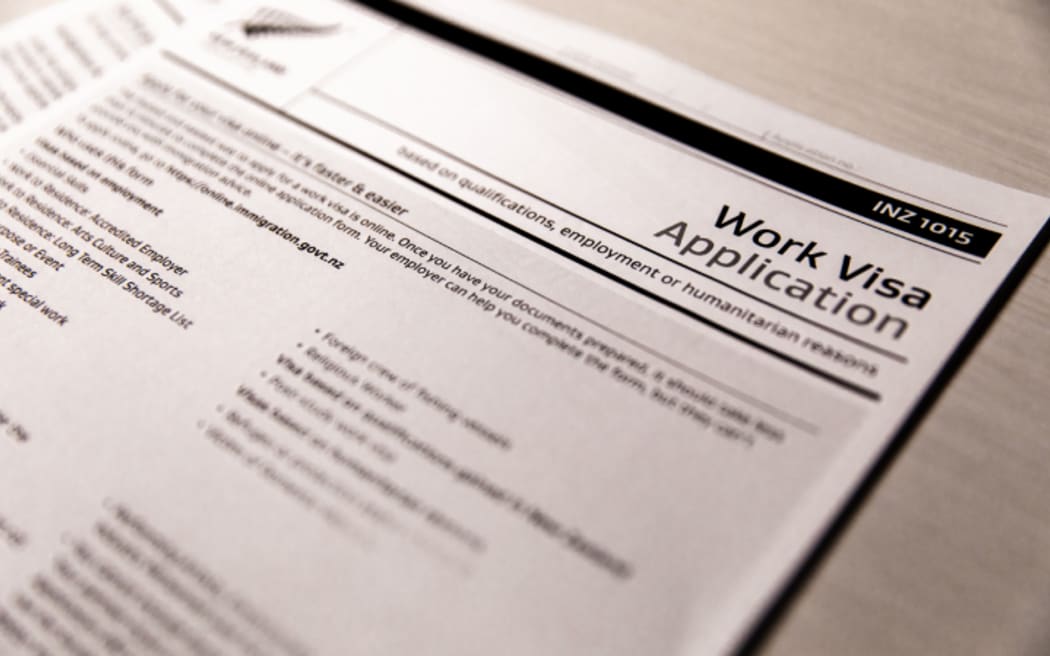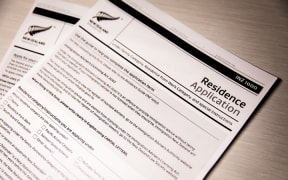
A review into the accredited employer work visas was released last week. Photo: RNZ / Samuel Rillstone
Analysis - It took three months for immigration officials to reverse a 'light touch' approach to work visa applications after it was told of concerns over lax checks and migrants buying jobs for up to $50,000.
The delay was one of several mistakes that spurred a rise in dodgy employers and worker exploitation that the immigration system was aiming to prevent, with some workers arriving into New Zealand to find they had no job.
Meanwhile, the winners were taking the spoils - the fraudulent agents and businesses are still in the shadows, but millions have been made from those who quickly saw how easy their job-selling work would be.
Stories abound about fraudulent employers who could set up, sell jobs and walk away with the cash, agents offshore who knew a money-making racket when they saw it. Last week's review into accredited employer work visas (AEWV) shows the missed opportunities for authorities to spot and stop the rampant fraud.
Read the Assurance review of the operation of the Accredited Employer Work Visa scheme
Immigration lawyer Alastair McClymont was the first to raise the alarm when his business partner returned from an overseas trip and reported what she had seen first-hand. Job tokens - effectively permits within AEWV denoting how many migrants a business could employ - were commanding $10,000 to $50,000 on the open market in Asia, with $40,000 a common amount in the summer of 2022/23.
"It was a boom for these people exploiting it," McClymont said. "You could make an honest declaration in your accreditation application that you were financially sustainable just by having a $1 profit for each of the last two 12-month periods. So a company that's made $1 profit in two years, suddenly has the ability to sell 20 job tokens on the open market for $30,000 each. If they [INZ] are going to be verifying this 24 months later, how much damage are they going to cause during those 24 months? And what are the consequences for that employer?
"I mean, we know employers and advisors that have made up to half a million dollars in a very short time through abusing the system. I've heard rumours of some people that made a half million bucks, closed the business down and moved to Australia."
RNZ twice asked Immigration New Zealand (INZ) in March 2023 whether it was aware of the seemingly widespread fraud, the amounts that were changing hands, and crucially whether the checks it was asking staff to undertake were less comprehensive than they used to be (under essential work visas which AEWV replaced in 2022). It did not directly reply: "We do accept that in most cases the employer is best placed to know who they are recruiting and how skilled or qualified they are," and "We check during the visa application stage that the applicant has the qualifications or work experience required for the role." It did say it was aware of two allegations of people paying a premium to an accredited employer.
The review says INZ was aware only of the fraud concerns in April. In any case, it did not change the instructions to immigration officers to tighten up their checks until June last year. By then a significant amount of the damage was done - recovery visas were also brought in weeks after last year's devastating February cyclone and they too - though not the subject of the official review - were sold to workers who did not always have the skills their visa said they would.

Immigration lawyer Alastair McClymont was the first to raise the alarm. Photo: Supplied.
High-trust
Introducing a high-trust model into a system well-known for abuses was just part of a series of events that set the visa on a perilous course as the border and visa processing re-opened in the winter of 2022.
The policy that became employer accreditation was welcomed when it was introduced by then immigration minister Iain Lees-Galloway after the 2017 election, though advocates have long called for workers to not be 'tied' to a business, so they can easily leave unscrupulous employers. The changes to the essential work visa - the main way overseas staff had in the past been allowed into NZ - and five other visa types, was aimed at curbing exploitation, and dealing with an "overly complex" visa system, which did not incentivise businesses to train their own staff or invest in technology.
It envisaged a three-stage process: Checks to ensure businesses were legitimate, job checks to verify that overseas workers were needed, finally a check on the migrant themselves. What any of those checks meant in detail and in practice, though, changed over time.
McClymont said one of the main flaws was that the policy was silent on what happened if businesses did not comply, and led to immigration staff not checking companies' pay and work records.
"When it became apparent to all of the employers and a lot of the immigration advisers that there was no compliance, that it was a trust model, that there was no checking up on the employers, it became a free-for-all." It was harder to defraud INZ under the previous essential work visas, he said, where compliance was upfront and immigration officers would look closely at suspect companies. Crucially, they would look at the whole picture - the business, the job market, the worker and their experience and qualifications.
Last week's review into how INZ implemented the AEWV policy, whose arrival was delayed by Covid-19, details the main types of fraud and exploitation that occurred. First, the migrant's employment may simply not exist, was no longer available, employment documents were falsified, or exploitation of the 90-day job-termination rule. Second, "offshore agents, potentially aided by on-shore actors, command[ed] significant fees for migrant workers, causing heavy debt and increased vulnerability". Other exploitation included under- or non-payment of staff.
It is difficult to quantify the extent of the fraud - not everyone complains. But by last month, 1958 complaints had been received against Accredited Employers. The number of the new migrant exploitation protection visas (MEPVs) increased from 63 in its first half-year in 2021, to 125 in 2022. Those numbers may have been partially affected by the border closure, but in the first 10 months of last year, 652 MEPVs were issued.
Another statistic - the proportion of AEWV applications being rejected declined, suggesting fewer problem applications were being found by INZ. Rejections of AEWV in 2023 (2.15 percent) was four times less than essential skills in 2019, when 8.42 percent were refused.
The immigration reset
When the government announced a "once-in-a generation reset" of the immigration system in May 2021, there was a belief the reliance on overseas labour had waned during Covid and would be tightly controlled once visa processing restarted.
The visa therefore would be timed to coincide with the border re-opening. It was to prove a fateful decision, as what seemed like a good opportunity to introduce the new regime was in fact the perfect storm.
Estimates of how many people would apply were wildly inaccurate, including visitors and workers. Legitimate businesses - about 80,000 of them - were finding it took weeks longer than a work visa used to, at a time when they were crying out for staff. The review outlines the mistakes made: an unprepared workforce, an uncompleted IT upgrade; opportunities ignored to listen to whistleblowers who tried to alert their superiors, huge volumes of applications, lack of risk assessments on decision-making.
Politicians and Immigration New Zealand were under pressure to act, to deal with huge volumes, delays and bad headlines. INZ would shift resources from visas allowing tourists, then work visas, and then visitor visas for relatives to see family in time for Christmas. Bubbling away under it all was the fast-track residence visa RV21, which the minister - then Kris Faafoi - had pledged would make 165,000 new residents in 12 months. That became 18 months, and it was less than half-a-year into that period when it opened employer accreditation visas in a phased three-stage process. RV21 had been the first difficult outing for its ADEPT IT system
A new Christchurch office and 200 recruits were among other changes as staff learned the ropes of AEWV and ADEPT. The 'back-end' of the ADEPT system was not operating when the accreditation portal opened. Within three days of opening 1151 Employer Accreditation applications were received. Five weeks after the Job Check gateway had opened, 2896 Job Check applications had been received but only 329 had been completed. By 23 August 2022, the Work Visa gateway had been open for just over seven weeks with 2284 applications received, of which only 139 had been completed. Complaints of delays and defects in the system were rife.
An incident management team was introduced in August 2022, three weeks after the border-reopened, and ran until 24 March 2023. The then immigration minister Michael Wood said it would bring more Ministry of Business, Innovation and Employment (MBIE) resources into INZ to 'unclog' and lift visa processing performance, later in admitting in October to 'pain points' in the system. INZ found 3000 visitor visa applications that had been lost for two to three months.
By then, a decision had been made about how to tackle the backlog - ruling out automation and increasing resources as impractical in the timeframe they were working to.
Instead, it decided to adjust 'risk tolerance' to accept more risk, according to last week's review. The risks of increased fraud and non-compliance were to be mitigated by only introducing the change for two months, by post-decision reviews (Accredited Employer Risk Monitoring and Review or AERMR) designed to identify risk trends and inform risk settings over time, increased Risk Management and Review to be undertaken by INZ's Risk & Verification Team and the re-accreditation of employers, which was to be undertaken after the first 12 months.
Accepting more visas 'at face value'
Most of the other checks and balances fell away in the months that followed: in December 2022, Cabinet agreed to extend all employer accreditations applied for before 4 July 2023 by 12 months; the planned implementation of AERMR was delayed by six months.
In AEWV visa processing: "The proposed streamlining will accept more documentation regarding skills, qualification, and experience at face value", a memo said. Immigration staff received new 'general instructions' changing how they were to approach some parts of the work visa processing from July 2022, four days before the border even opened.
Checks on job roles and migrants would be limited - reducing the amount of verification immigration officers were required to undertake.
And whereas those moves were only meant to last two months, they were extended by the Incident Management Team (IMT) in October 2022 and February 2023. New instructions which "re-introduced some checks to reduce the risk exposure to the scheme in response to multiple examples of immigration risks materialising and being observed by INZ" came in June 2023.
"Similarly, and consistent with the original approval, the IMT operating at the time should have undertaken a structured review and risk assessment to understand the specific risks being accepted before extending the General Instructions," the review concluded.
Media reports show immigration advisers, unions and migrants raising the alarm, and the review found INZ staff started blowing the whistle from April last year. The review said: "Discussions with INZ leadership indicate that, at the time, there was limited evidence of visa system abuse presenting through INZ's risk monitoring activity, which was consistent with their belief that nothing in the general instructions required immigration officers to ignore risk, and that concerns were largely reflective of some staff not necessarily understanding the policy and operational settings relating to the scheme.
"As well as this disconnect being demoralising for some staff, this was a missed opportunity for the system to learn, improve, and mitigate further harm, based on the intelligence gathered at the frontline."
What did ministers know and when? The review asked for evidence that potential immigration risks were clearly described to the immigration minister. "Senior MBIE and INZ officials have responded to the review that Ministers were fully appraised of the risks (as they were known by MBIE and INZ at the time) through oral briefings throughout the implementation of AEWV and that at times during the implementation, daily processing volume information was provided to Ministers to provide assurance regarding performance. Senior MBIE and INZ officials advise no written briefings of these risk or file notes of oral briefings exist."
ADEPT's nickname was 'Inept'
"The prevalent sentiment from frontline staff interviewed by the review was that, at the time of launch, ADEPT was not ready, not fit for purpose, and staff described this period as 'hell, chaotic and frustrating'," the review said.
Figures released under the Official Information Act show $56.6 million was spent on the ADEPT project, which officially closed two months after the border reopened. From that $56m, $39.6m went on the Employer Direct Project (EDP) to implement Employer Accreditation, Job checks and the Accredited Employer Work Visas.
It was being built as it was being used, two systems were in use at the same time and user testing could not happen before being deployed in a live environment, the review noted.
Immigration officers were no longer in charge of a whole work visa, and so could not take into account what they already knew about a suspect application, only complete their specific task and then pass the case on.
Staff were also feeling the pressure to get through their work. "Some staff spoken to conveyed how they were encouraged to "ring the bell" at the completion of an application while others reported feeling "named and shamed" if they missed processing targets or managers using "league tables" of processing volumes in team meetings... the culmination of factors at play to ensure the borders could be reopened successfully, reinforced the view for staff that achieving processing volumes was all that mattered at this time.
"Staff were beginning to raise concerns to senior managers in early 2023, although frontline staff interviewed reported concerns had been raised with managers relating to individual cases prior to this. Immigration officers reported to the review that the instruction from managers was not to investigate anything that was not raised as a risk in ADEPT and that they needed to 'trust the system'."
They filled out many 'No Surprise Fact Sheets', brought it up in staff hui (Ask Me Anything) and talked to the media. INZ management did not pay enough attention, according to the review, instead rationalising that staff did not understand the automation of risk management through ADEPT, there was inadequate evidence of visa system abuse and that staff could exercise their discretion to consider approving or rejecting visas.
By the time a staff member wrote directly to then immigration minister Andrew Little to blow the whistle in August last year and he ordered a Public Service Commission review, the damage was by and large already done. The visas that had been approved, the non-existent jobs, the migrants already here without work were translating into a tide of human misery.

New Immigration Minister Erica Stanford plans to bring proposals for immediate changes to the Accredited Employer Work Visa (AEWV) to Cabinet. Photo: RNZ / Angus Dreaver
Winners and losers
The losers in the New Zealand work visa saga are very visible, migrants from countries where paying for a job and visa is not as outlandish as it sounds to New Zealand ears; families who sold everything for their future. The 'winners' - the employers or agents that took the cash and defrauded the system - may yet face compliance action or even criminal charges, but for now the ledger is not even.
The review notes that migrant exploitation is not a new phenomenon. But by the start of this month almost 2000 complaints had been made against accredited employers, and the exploitation has been visibly worse over the last year than pre-Covid years. Stories of overcrowded living situations, migrants who had turned to crime, families who were penniless after selling up at home to make their new life in New Zealand.
Voluntary migrant worker support services report huge increases in the numbers of individuals who have come forward for support, and they believe that is the tip of the iceberg.
RNZ reporter Lucy Xia remembers seeing a man crouched down at the side of the road in her neighbourhood, smoking a cigarette, looking distressed. She talked to him - the construction job he had bought with the last of their savings for more than $10,000 was a sham, he had a wife who was thinking of divorcing him, a one-year-old child back in China. He had lost the job after a week in the country and did not have a penny to his name.
Foodbanks, citizens' advice bureaux, unions and advocates all report helping migrants stuck in similar circumstances, in poverty, feeling trapped, and still hoping they could turn things around.
Migrants are still being exploited even though compliance action is now being stepped up. Not all victims have come forward, as they are worried about the ramifications for their future here.
New Immigration Minister Erica Stanford plans to bring proposals for immediate changes to the Accredited Employer Work Visa (AEWV) to Cabinet, as well as longer-term work on IT and policy.
Immigration adviser Katy Armstrong said the review showed how badly INZ dropped the ball.
"I just want a system that is rational, functional, that I can stand by proudly and say this is really a great system," she said. "For the last 18 months, I haven't hand on heart been able to say that."





